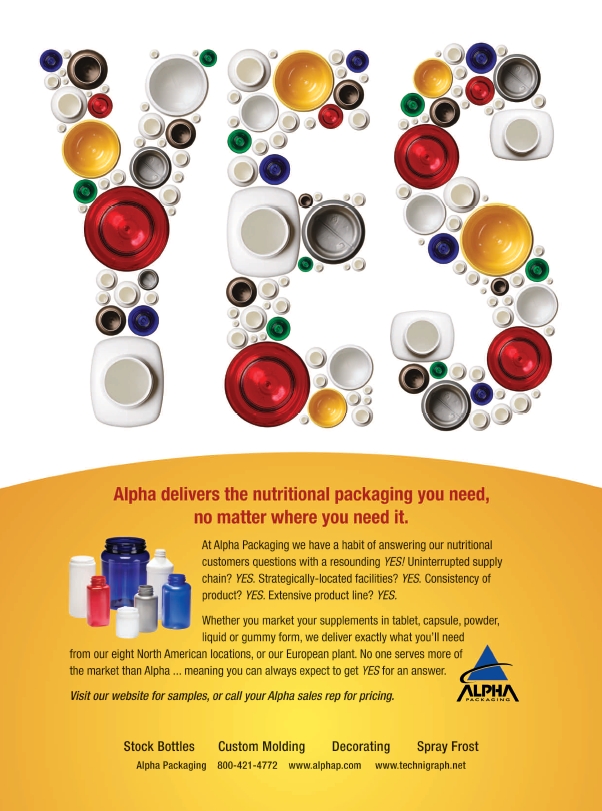While manufacturers are hard at work on new product formulations to better serve their customers, packaging companies are focused on the task of serving theirs, as well. Much thought and investment go into producing these containers before finished product makers can finally place their products into them. Here’s a look at the regulations, innovations and eco-friendly trends impacting the packaging sector.
Packaging by the Rules
Packaging companies can’t just go about their business however they want. Requirements are handed down to them from government and up to them from clients on everything from the materials used to procedures followed. For instance, the impact of California’s Rigid Plastic Packaging Container (RPPC) law is explained by Marny Bielefeldt, director of marketing at Alpha Packaging, St. Louis, MO. “We have many customers in the natural products sector who sell their products in the State of California, so those companies want to make sure their packaging complies with RPPC,” she says.
It applies to all products (not just natural products) using rigid packaging eight-ounces and larger. “But since so many of Alpha’s customers are in the nutritional and natural products industry, we have a very high percentage of customers who need guidance on the regulations,” Bielefeldt says. The law, implemented in 1995, stipulates that rigid containers meet at least one of several requirements designed to cut down on waste. One option is to produce containers that are composed of at least 25% recycled content.
In addition to the U.S. Food and Drug Administration (FDA) regulations that have been standard for food packaging companies for years, even more checkup is now required, according to Anthony Gentile, director of marketing for Xela Pack, Inc., Saline, MI. He says many of the natural products for which his company provides packaging are food products, and sometimes they are organic certified. “We need to comply with those regulations, as well, to be able to provide our customers with the packaging they need,” Gentile says. He explains that his company sought and achieved organic certification to be able to package certified organic products.
Good manufacturing practice (GMP) certification through a third-party food safety audit, he says, has helped keep his company in compliance. Gentile adds that his company has also had NSF certify its staff on Hazard Analysis and Critical Control Points (HACCP) training. HACCP is “a systematic, science-based approach for the identification, evaluation and control of food safety hazards,” according to NSF.
Eco-Friendly Futures
The most seismic changes in packaging continue to occur in the area of sustainability.
This doesn’t just mean that more packages are recyclable than ever before. The concept of packaging sustainability entails the materials used, the efficiency of designs and the innovation needed to make new materials and designs function properly. It even means improving on the environmental impact of producing and transporting packaging.
Elisabeth Comere, director of environment and  government affairs for Tetra Pak, Inc., Vernon Hills, IL, says that in all of her company’s efforts to innovate, sustainability is kept at the forefront. This includes integrating the principles of the Environmental Protection Agency’s Design for the Environment Program (DfE). “The environment is never an afterthought. It is embedded in our R&D process,” Comere says.
government affairs for Tetra Pak, Inc., Vernon Hills, IL, says that in all of her company’s efforts to innovate, sustainability is kept at the forefront. This includes integrating the principles of the Environmental Protection Agency’s Design for the Environment Program (DfE). “The environment is never an afterthought. It is embedded in our R&D process,” Comere says.
As to specific innovations, Bielefeldt notes a renewed interest in making rigid plastic bottles lighter weight. So-called “light-weighting” is more suited to some rigid containers than others, she says. For instance, it is possible to take too much gram weight out of a plastic bottle, making progress in this area a delicate matter. “If a bottle’s walls are too thin, it can collapse under the weight of filled containers during shipping, or be difficult to label on conventional filling lines,” Bielefeldt says. She says that innovations in light-weighting include structural ribbing to strengthen the sidewalls of packages, and optimization of the preform molds used to make rigid containers.
Gentile says his company’s packaging utilizes a polyethylene liner inside a recycled paper outer package, thus cutting down on plastic while still maintaining a usable and attractive package. He applauds a similar design by another company, Ecologic Brands, that uses the same plastic inside/paper outside design, but with larger and more rigid bottles. This allows the pouch inside these bottles to be removed from the outer shell. The inner plastic pouch can then be recycled and the outer paper shell can be recycled or composted. Overall, Gentile says this is a great concept that can help companies reduce the amount of plastic they use in packaging.
The most interesting eco-friendly advancements to Bielefeldt involve the plastics arena, particularly plant-based resins. Innovators are using sources such as straw or sugar cane to mimic the building blocks of polyethylene terephthalate (PET) and high-density polyethylene (HDPE), she explains, stating, “These are exciting because they are able to replace a component that used to be petroleum-based with something plant-based, but still wind up with the same resin (and the same performance characteristics) after the reformulation.” A major factor that sets plant-based PET and HDPE apart from other “new” resins like PLA or PHA is that plant-based bottles can be recycled in the regular PET and HDPE recycling streams, Bielefeldt adds.
Another eco-friendly capability involves shipping. By stacking and shipping pallets of bottles in single layers packed in recyclable plastic bags, instead of corrugated cartons, Bielefeldt’s company achieves multiple benefits. One is that the customer can receive 35–40% more bottles on every efficiently packed truck. Another is that the use of perforated plastic bags eliminates the need for cartons. “A normal pallet of Alpha bottles is composed of 20 corrugated cartons, whereas the bagged configuration usually only has a thin slip sheet of corrugate between every third or fourth layer of bottles,” she says.
Comere’s company focuses on the entire life cycle of products, “from shipping to shelf space to recyclability,” she says. The company’s innovations also go beyond the core of the package to address areas like caps and closures, the pouring and drinking experience for beverage packages, and advanced filling and processing equipment.
Bio-based package caps made from sugar cane is one recent development, according to Comere. She adds that her company has also announced a pilot trial in Brazil that will use a bio-based material (sugar cane) to produce low-density polyethylene (LDPE), which will then be used for the plastic in the company’s carton packages. These initiatives, Comere says, represent steps toward the company’s ambition of making packaging entirely from renewable materials.
In answer to the traditional gallon jug of milk, Comer says her company has introduced an aseptic, shelf-stable package for milk with unique attributes. The core of the package is a carton, but it is shaped like a bottle, thus offering the easy handling and pouring of a bottle with the environmental benefits of a carton. The packages also feature a separable top for easy recycling of the carton portion.
By working with the Carton Council of North America, Comere explains that her company has also made progress toward developing the infrastructure needed to expand carton recycling in the U.S. “Today 46% of U.S. households across 45 states have access to carton recycling and that number is growing literally every day,” she says. She also notes that the filling equipment the company offers to manufacturers is the first to receive an Environmental Product Declaration (EDP) certification. Compared with its predecessor, the filling line consumes 11% less energy, produces 30% less waste, and uses 70% less water and 80% less cleaning agents.
As a general policy, Gentile says that his company is always evaluating new processes and solutions for improving the eco-friendliness of its packaging. Strategies it has considered and implemented over the years include reducing plastic use and overall packaging material, using recycled and responsibly sourced paper, using green energy, using processes that require limited electricity and others.
“Our main challenge is bringing new concepts and new materials to such a small package at an affordable cost. As any supplier of environmentally conscious packaging knows, we need to make sure that everything we do is cost-effective so that our customers aren’t financially burdened by making the switch to environmentally conscious packaging,” Gentile says.
This dynamic holds in any industry where eco-friendly ideas are contending with tradition, he adds. The key is making the decision to switch easier for companies by not disturbing their bottom line. Gentile says, “We’ve been successful doing this so far, and with the added benefits of customer appeal and brand recognition, we’re getting to a point where our customers find it’s financially advantageous to use our packaging.” WF
Reference
1. “Understanding California’s RPPC Law,” Californians Against Waste, http://www.cawrecycles.
org/issues/rppc, accessed Dec. 2, 2013.
Published in WholeFoods Magazine, January 2014









